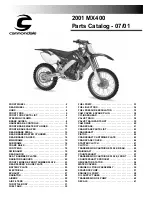
3-16
CHASSIS
Do not force the adjuster past the
minimum or maximum extent of
adjustment. The adjuster may be
damaged.
ADJUSTING THE REAR SHOCK
ABSORBER LOW COMPRESSION
DAMPING FORCE
1. Adjust:
• Low compression damping force
By turning the adjuster "1".
• STANDARD POSITION:
This is the position which is back
by the specific number of clicks
from the fully turned-in position.
(Which align the punch mark "a"
on the adjuster with the punch
mark "b" on the high compression
damping adjuster.)
Do not force the adjuster past the
minimum or maximum extent of
adjustment. The adjuster may be
damaged.
ADJUSTING THE REAR SHOCK
ABSORBER HIGH COMPRESSION
DAMPING FORCE
1. Adjust:
• High compression damping force
By turning the adjuster "1".
• STANDARD POSITION:
This is the position which is back
by the specific number of turns
from the fully turned-in position.
(Which align the punch mark "a"
on the adjuster with the punch
mark "b" on the adjuster body.)
Do not force the adjuster past the
minimum or maximum extent of
adjustment. The adjuster may be
damaged.
CHECKING THE TIRE PRESSURE
1. Measure:
• Tire pressure
Out of specification
→
Adjust.
• Check the tire while it is cold.
• Loose bead stoppers allow the tire
to slip off its position on the rim
when the tire pressure is low.
• A tilted tire valve stem indicates that
the tire slips off its position on the
rim.
• If the tire valve stem is found tilted,
the tire is considered to be slipping
off its position. Correct the tire posi-
tion.
CHECKING AND TIGHTENING THE
SPOKES
The following procedure applies to all
of the spokes.
1. Check:
• Spokes
Bend/damage
→
Replace.
Loose spoke
→
Retighten.
Tap the spokes with a screw-
driver.
A tight spoke will emit a clear, ringing
tone; a loose spoke will sound flat.
2. Tighten:
• Spokes
(with a spoke nipple wrench "1")
Be sure to tighten the spokes before
and after break-in.
Stiffer "a"
→
Increase the low
compression damping force.
(Turn the adjuster "1" in.)
Softer "b"
→
Decrease the low
compression damping force.
(Turn the adjuster "1" out.)
Extent of adjustment:
Maximum
Minimum
Fully turned in
position
20 clicks out
(from maximum
position)
Standard position:
11–14 clicks out
Stiffer "a"
→
Increase the high
compression damping force.
(Turn the adjuster "1" in.)
Softer "b"
→
Decrease the high
compression damping force.
(Turn the adjuster "1" out.)
Extent of adjustment:
Maximum
Minimum
Fully turned in
position
2 turns out
(from maximum
position)
Standard position:
1-3/8±1/6 turns out
Standard tire pressure:
100 kPa (1.00 kgf/cm
2
,
15 psi)
Summary of Contents for YZ125 2016
Page 4: ......
Page 12: ...1 2 LOCATION OF IMPORTANT LABELS EUROPE...
Page 13: ...1 3 LOCATION OF IMPORTANT LABELS AUS NZ ZA...
Page 61: ...3 18 CHASSIS...
Page 165: ......
Page 166: ...PRINTED IN JAPAN E PRINTED ON RECYCLED PAPER...
















































